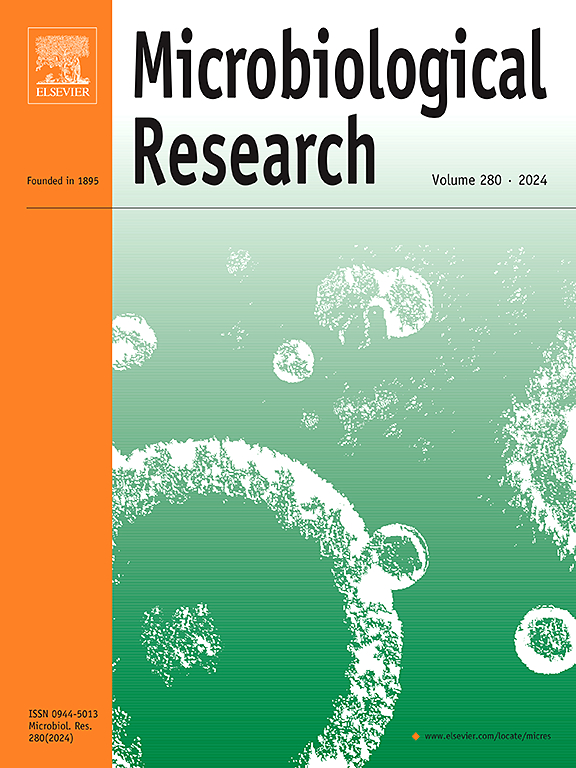Host phylogeny and traits shape the composition and network structure of the phyllosphere microbial communities in temperate desert plants
IF 6.9
1区 生物学
Q1 MICROBIOLOGY
引用次数: 0
Abstract
Phyllosphere microorganisms play a vital role in enhancing the adaptability and functionality of their host plants. Although the effects of phyllosphere microbial communities on host functional traits and their association with host phylogeny has been widely investigated, it remains unclear whether host selection consistently drives the assembly of these communities. In this study, bacterial and fungal communities on the surfaces of 734 leaf samples were characterized using bacterial and fungal amplicon sequencing. These microbial communities were associated with 42 plant species native to the Gurbantunggut Desert, a representative temperate desert located in Central Asia. The research assessed the relative contributions of plant-related factors, abiotic environmental variables (such as climate and soil), and spatial components to the observed variation in phyllosphere microbial communities, and further inferred the topological structure of plant-microbe interaction networks. The results indicate that plant phylogeny, plant functional traits, abiotic environment conditions, and spatial factors account for variations in the bacterial community composition (36.4 %, 4.6 %, 1.0 %, and 0.1 %, respectively) and the fungal community composition (28.6 %, 3.0 %, 1.5 %, and 1.2 %, respectively), following a hierarchical trend of plant phylogeny > plant functional traits > abiotic environment > space. Plant phylogeny and functional traits play a central role in shaping the assembly of phyllosphere microbial communities, indicating that plant filtering effects significantly influence microbial composition. Analysis of plant-microbe interactions reveals distinct preferences of microbial taxa for plant hosts across different taxonomic levels and geographic regions. Bipartite network analysis further illustrates that plant-microbe networks are highly specialized and modular, with plant-fungal networks exhibiting greater host specificity compared to plant-bacterial networks. Collectively, these findings underscore plant filtering as the primary determinant of microbial community assembly in the desert phyllosphere and provide valuable insights into the macroecological patterns shaping plant-microbe interactions in arid ecosystems.
寄主系统发育和性状决定了温带荒漠植物层圈微生物群落的组成和网络结构。
层球微生物在提高寄主植物的适应性和功能方面起着至关重要的作用。虽然层球微生物群落对宿主功能性状的影响及其与宿主系统发育的关系已被广泛研究,但尚不清楚宿主选择是否始终驱动这些群落的聚集。本研究利用细菌和真菌扩增子测序对734个叶片样品表面的细菌和真菌群落进行了表征。这些微生物群落与古尔班通古特沙漠的42种植物有关,古尔班通古特沙漠是中亚温带沙漠的代表。本研究评估了植物相关因子、非生物环境变量(如气候和土壤)和空间分量对层际微生物群落变化的相对贡献,并进一步推断了植物-微生物相互作用网络的拓扑结构。结果表明,植物系统学、植物功能特征、非生物环境条件和空间因素占细菌群落组成的变化(36.4 %, % 4.6,1.0 %,和0.1 %,分别)和真菌社区组成(28.6 % 3.0 %, % 1.5和1.2 %,分别),后植物系统学的层次化趋势> 植物功能性状> 非生物环境> 空间。植物的系统发育和功能性状在层层微生物群落的形成中起着核心作用,表明植物的过滤作用显著影响着层层微生物群落的组成。植物-微生物相互作用的分析揭示了不同分类水平和地理区域的微生物类群对植物寄主的不同偏好。二部网络分析进一步表明,植物-微生物网络是高度专业化和模块化的,与植物-细菌网络相比,植物-真菌网络表现出更大的宿主特异性。总的来说,这些发现强调了植物过滤是沙漠层圈微生物群落聚集的主要决定因素,并为干旱生态系统中形成植物-微生物相互作用的宏观生态模式提供了有价值的见解。
本文章由计算机程序翻译,如有差异,请以英文原文为准。
求助全文
约1分钟内获得全文
求助全文
来源期刊

Microbiological research
生物-微生物学
CiteScore
10.90
自引率
6.00%
发文量
249
审稿时长
29 days
期刊介绍:
Microbiological Research is devoted to publishing reports on prokaryotic and eukaryotic microorganisms such as yeasts, fungi, bacteria, archaea, and protozoa. Research on interactions between pathogenic microorganisms and their environment or hosts are also covered.
 求助内容:
求助内容: 应助结果提醒方式:
应助结果提醒方式:


